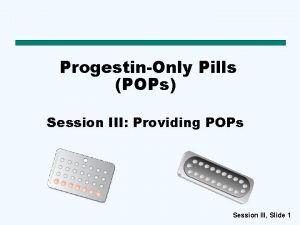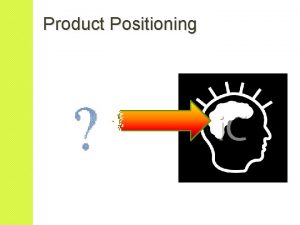COMPETITIVE POSITIONING PODS POPS Nirma is differentiated on











- Slides: 11


COMPETITIVE POSITIONING PODS & POPS: • Nirma is differentiated on account of economy. • Pepsodent – germi – check & post brushing effectiveness • Creating differentiation is a crucial determinant of brand success. • POD is essential but not sufficient for a brand to sustain against the competition.

COMPETITIVE POSITIONING • Points of parity / frame of reference are also needed. • Customers use to see the common features existing in same products to evaluate brands. • Frame of reference will help to visualize & create a customer expected product.

COMPETITIVE POSITIONING 1. Frame of reference in same product category: • Mirinda’s frame of reference is fanta • Hyundai getz frame of reference is maruti swift. Features common: orange soft drink mid – size compact car.

COMPETITIVE POSITIONING 2. Point of parity in different product category • Customers think about the brand in different category. • Cadbury compared with local ready snacks / sweets.

COMPETITIVE POSITIONING 3 ways of building differentiation: 1. Product/ brand performance: product dimensions like durability, reliability, price, style 2. Imagery: associated with class of people using – high – Rolls Royce ordinary – fair & lovely 3. If above 2 doesn’t work the marketer can concentrate insight problems & goals of the consumers

POSITIONING STRATEGIES Positioning involves what associations are to be created and what have to be removed. Attribute positioning: Associated with product attributes, benefits & features. Eg. Annapurna salt: iodized salt. Pears – original glycerin soap

POSITIONING STRATEGIES Price / Quality positioning: Brand may be positioned as “high quality high price” – quality conscious customers. Highlighting the low price of the product for cost conscious customers. eg. Wheel – less price Surf – premium product

POSITIONING STRATEGIES Use / Application positioning: • Developing a Connection between brand & use it is to put to. • For what the product has to be used: Eg. Pidilite – paste to be used for leaking pipes Eg. Vicks vapourup – applied on child’s chest for quick relief

POSITIONING STRATEGIES User positioning: Developing a connection between brand the user / user class. Positioning by specifying for whom the product is manufactured(target consumer) Eg. Johnson & Johnson – kids & infants.

POSITIONING STRATEGIES Product class positioning: To which product category it belong to Eg. Nescafe – instant coffee Eg. Mr. Bean – filter coffee





















